Society and Diplomacy at Sea: SS Minnehaha First Class Passenger List – 5 February 1910
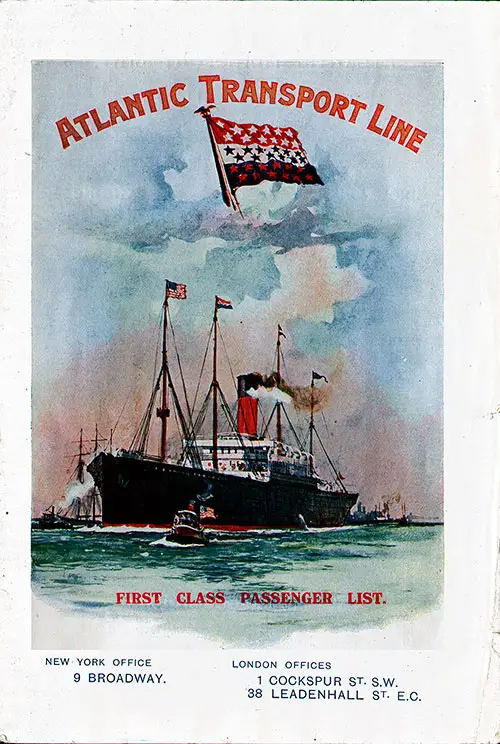
Front Cover, SS Minnehaha First Class Passenger List Departing 5 February 1910 from Southampton to New York, Commanded by Captain Sydney Layland. | GGA Image ID # 1731c62557
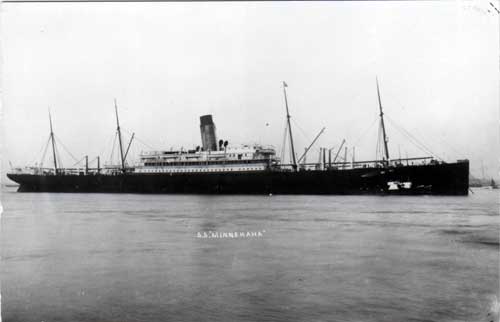
Photograph of the SS Minnehaha of the Atlantic Transport Line, 1900. | GGA Image ID # 1fc6e4c748
🚢 Review & Summary
The SS Minnehaha of the Atlantic Transport Line set sail on 5 February 1910, departing from Southampton to New York under the command of Captain Sydney Layland. This First Class passenger list captures a fascinating cross-section of early 20th-century society—diplomats, consular officials, businessmen, families, clergy, and social figures making the transatlantic journey.
By 1910, the Minnehaha was already well established in service, recognized as one of the "Big Four" ships of the Atlantic Transport Line, specializing in carrying First Class passengers and high-value cargo such as horses, perishable goods, and luxury items. This sailing highlights the ship’s reputation as a comfortable yet purposeful vessel linking London and New York’s social and business elites.
⚓ About the SS Minnehaha
- Launched: 31 March 1900 by Harland & Wolff, Belfast.
- Operator: Atlantic Transport Line (later part of International Mercantile Marine).
- Route: London–New York, catering exclusively to First Class passengers (no steerage).
- Tonnage: Approx. 13,400 gross tons.
- Features: Known for spacious saloon accommodations and for carrying both luxury passengers and valuable cargo, including racehorses.
- Later History: Torpedoed and sunk during WWI in 1917 by German submarine U-48, but remembered for its elegant service in the pre-war years.
Senior Officers and Staff
- Commander: Captain Sydney Layland
- Surgeon: H. R. Datley
- Chief Engineer: Neil K. Maclean
- Purser: M. R. Hamand
- Chief Steward: William Sismey
First Class Passengers
- Mr. Johannes G. Bassoe
(Norwegian Vice-Consul, New York) - Mr. Lewis H. Brown
- Mrs. Lewis H. Brown
- Mr. L. H. Brown
- Mr. Barry N. Bishop
- Mr. W. H. Byrd
- Mr. Frank L. Chapman
- Mr. E. Clavel
- Mr. M. X. Costikyan
- Mr. Herman H. Deiden
- Mr. Henry George
- Mr. Arthur Hall
- Mrs. Arthur Hall
- Mr. W. H. Harbeck
- Mr. Beter Hopley
- Mr. Clias. L. Howes
- Mrs. Ohas. L. Howes
- Mr. C. P. Hurditch
- Mr. Felix S. S. Johnson, (American Consul, Bergen, Norway)
- Mrs. Felix S. S. Johnson
- Mrs. Lefroy
- Mr. Lang Lefroy
- Mr. A. E. Lane
- Mr. J. H. McMillen
- Mr. Simon Nederveld
- Mr. Alfred C. Pennock
- Mrs. Alfred C. Pennock
- Mrs. F. Pocock
- Miss G. Pocock
- Mr. Louis F. Post
- Mr. Martin Scheak
- Mrs. Martin Scheak
- Master Harrison Scheak
- Mrs. H. B. Shephard
- Miss Marjorie Shephard
- Mrs. M. L. Simmonds
- Master Fredk. Simmonds
- Miss Alice Stringer
- Rev. J. F. Smith
- Mrs. J. F. Smith
- Miss F. B. Smith
- Miss E. E. Smith
- Mrs. C. W. Siesel
- Mr. Sidney M. Siesel
- Mr. G. L. Terrasse
- Mrs. G. L. Terrasse and Child
- Miss Ruth Underhill
- Mr. Archdale Wilson
- Mrs. Archdale Wilson
- Miss Katherine Wilson
- Mr. B. T. Wilson
🌍 Notable Individuals
🏛 Diplomats & Consular Figures
Mr. Johannes G. Bassoe – Serving as the Norwegian Vice-Consul in New York, Bassoe was an important link between Scandinavian emigrants and their new homeland. His presence underscores the diplomatic role played by Atlantic crossings.
⚖️ Felix S. S. Johnson – American Consul in Bergen, Norway, representing U.S. interests in Scandinavia during an era of increasing transatlantic trade, traveling with his wife. Johnson’s role as a U.S. representative abroad highlights the increasing global reach of American diplomacy at the dawn of the 20th century.
✝️ Religious Figures
Rev. J. F. Smith – Accompanied by his family, Rev. Smith exemplifies the tradition of clergy traveling on liners to provide spiritual guidance. Ministers were often called upon to hold Sunday services at sea, and his presence suggests such a role on this voyage.
🎩 Business & Political Figures
Mr. Louis F. Post – A distinguished passenger, Post was a progressive journalist, lawyer, and later U.S. Assistant Secretary of Labor (1913–1921). He became known for his role in curbing the Palmer Raids during the Red Scare. His inclusion elevates this passenger list into the political sphere.
Mr. M. X. Costikyan – Likely a member of the prominent Costikyan family of New York, importers of Oriental rugs. His presence highlights the strong commercial and cultural links across the Atlantic.
🌟 Engaging Family Groups & Society Travelers
Mrs. F. Pocock and Miss G. Pocock, Mrs. H. B. Shephard and Miss Marjorie Shephard, and the Wilson family (Mr. Archdale Wilson, Mrs. Archdale Wilson, Miss Katherine Wilson, Mr. B. T. Wilson) reflect the social dimension of First Class travel—wealthy families combining leisure with international connections.
Miss Ruth Underhill – Possibly the anthropologist and later professor (if this is the same individual), she represents the rising intellectual opportunities for women in this era.
Information for Passengers
A fascinating window into shipboard rules, wireless rates, and daily life.
Meals
- Tea And Coffee .. at 7 a.m
- Lunch 1:00 pm
- Breakfast .. .. 8.30 a.m
- Dinner .. .. 7:00 pm
Meals for Nurses and Children Breakfast, 8:00 am; Dinner, 12 noon; Tea, 5:00 pm
Please apply to Second Steward for seating accommodation at Table.
Lights in the Saloon are extinguished at 11:00 pm, and in the Smoking Room at 11:30 pm
Bar closes at 11:00 pm
Smoking is not allowed in the Saloon, State-rooms or Companion-ways.
The Saloon Steward will supply Stamps, Telegraph Forms, Books of Reference, and Railway Time Tables of the Principal Companies.
Divine Service.—Intimation regarding Divine Service will appear on the Notice Boards every Sunday morning.
Valuables.—Passengers are enjoined to be very careful in the disposal of small articles of baggage, more especially during Embarkation, when there are always strangers on Board.
The Atlantic Transport Line has provided a Safe in the office of the Purser in which Passengers may deposit Money, Jewels, or Ornaments for safe keeping. The Company will not be liable to Passengers for the loss of Money, Jewels, or Ornaments, by theft or otherwise, not so deposited.
For the convenience of Passengers the Purser is prepared to exchange a limited amount of English and American money. The rate of exchange will be $4.80 to th 3 £ when giving American in exchange for English currency, and £1 to $4.95 when giving English money for American.
Baggage.—Only hand-bags and trunks which will fit underneath the berths are allowed in the State-rooms; all large or heavy baggage must be placed in the Baggage Room, to which access can be gained by applying to the Officer in charge of Baggage.
Passengers will greatly expedite the disembarkation if they will have their State-room Baggage packed ready for removal directly on arrival, so that the transfer may at once be proceeded with.
Baggage Checked From Pier At New York To Destination.—Upon arrival in New York steamers are met by uniformed representatives of the Railroads, from whom tickets« can be purchased and baggage checked from the pier to any point on the Lines of the Pennsylvania, New York Central, Lehigh Valley, and connecting Railroads.
Electric Bell Calls.—For Steward, one ring; for Stewardess, two rings.
Passengers’ Addresses should be left with the Purser, in order that any letters sent to the care of the Company may be forwarded.
Letters.—'Passengers may have their letters addressed to any of the Company’s Offices given below, where they will be retained until called for, or forwarded according to instructions.
The Surgeon is authorized to make customary charges, subject to the approval of the Commander, for treating any passengers at their request for any illness not originating on board the ship. In the case of sickness developed on board no charge will be made and medicine will be provided free in all circumstances.
Travellers’ Checks, payable in all parts of Europe, can be purchased at all the principal offices of the Atlantic Transport Line. These Checks are accepted on board Atlantic Transport Steamers in payment of accounts, but the Pursers do not carry funds to enable them to cash same.
Wireless Telegram Rates.
United States.—The minimum Marconi Rate, via Seagate, or through the medium of a passing steamer and this station is 8s. 4d. for ten words. Each extra word 6d.; text only counted; address and signature free; land charges additional; all fees must be prepaid
The minimum Marconi Rate, via Seagate, Sagaponack or South Wellfleet (Cape Cod), or through the medium of a passing steamer and one of these stations is 8s. 4d. for ten words. EG ch extra word, 6d.; text only counted; address and signature free; land charges additional; all fees must be prepaid.
The minimum rate via Siasconsett or Cape Race, or through the medium of a passing steamer and these stations is 12s. 6d. for ten words. Each extra word 9d.; text only counted; address and signature free; land charges additional; all fees must be prepaid.
The minimum Marconi Rate via Sable Island, or through the medium of a passing steamer and this station is 16s. 8d. for ten words. Each extra word Is.; text only counted; address and
signature free; land charges additional; all fees must be prepaid.
United Kingdom.—The Marconi Rate via Crookhaven, or other stations in the United Kingdom, or through the medium of a passing steamer is 10d. per word; every word in address, text, and signature counted; land charges additional; all fees must be prepaid.
Ship To Ship is 8d. per word; every word in address, text, and signature counted, and all fees must be prepaid
🎯 Relevance of the Voyage
For Teachers & Students: Demonstrates the interplay of diplomacy, religion, and business during the Edwardian era. Ideal for classroom discussion on how ocean liners shaped cultural and political exchange.
For Historians: Provides a primary source showing the social hierarchy of First Class passengers and the broader context of U.S. diplomacy and progressive politics in 1910.
For Genealogists: Offers family connections, marital groupings, and notable names that may tie to transatlantic family histories.
💡 Final Thoughts – Why This Passenger List Matters
The 5 February 1910 voyage of the SS Minnehaha captures a vibrant cross-section of Edwardian society: diplomats linking nations, progressive thinkers like Louis F. Post, and families traveling in style. What makes this list especially engaging is its combination of political, consular, and social figures, painting a portrait of transatlantic travel not just as a means of transport but as a stage for international exchange.
The inclusion of consuls, clergy, and reformers highlights the diverse purposes of travel—professional, spiritual, and social—all converging in the refined spaces of the Minnehaha’s First Class accommodations.
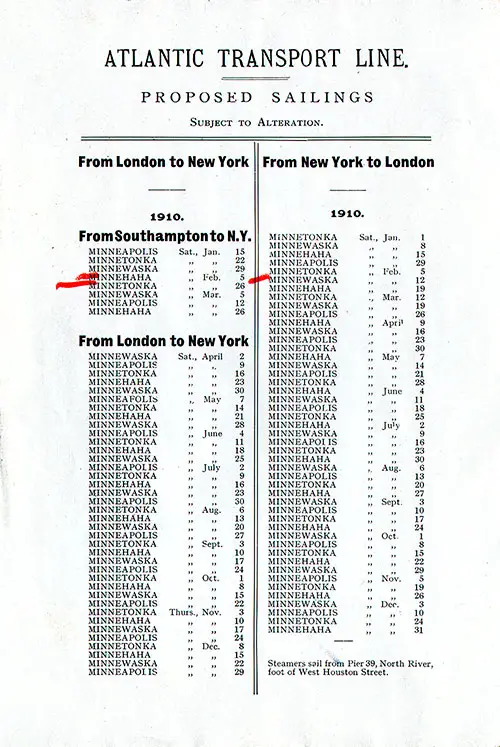
ATL Sailing Schedule, London-New York Service, From 1 January 1910 to 31 December 1910. Ships Included the Minnehaha, Minneapolis, Minnetonka, and Minnewaska. Ships Departing From New York Sail From Pier 39, North River, Foot of West Houston Street. SS Minnehaha First Class Passenger List, 5 February 1910. | GGA Image ID # 22c5d9dc04

Title Page, Listing of Senior Officers, List of Pasengers, Part 1 (Bassoe-Johnson). SS Minnehaha First Class Passenger List, 5 February 1910. | GGA Image ID # 22c6bd430e
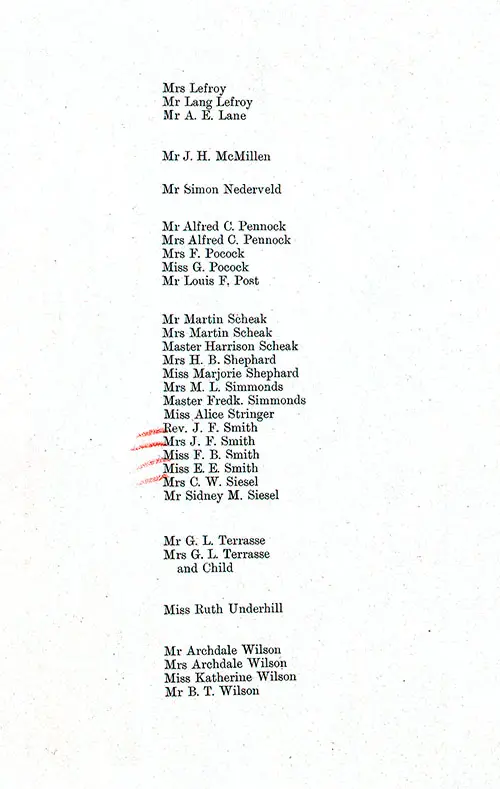
List of Passengers, Part 2 (Lefroy-Wilson). SS Minnehaha First Class Passenger List, 5 February 1910. | GGA Image ID # 22c71a224c
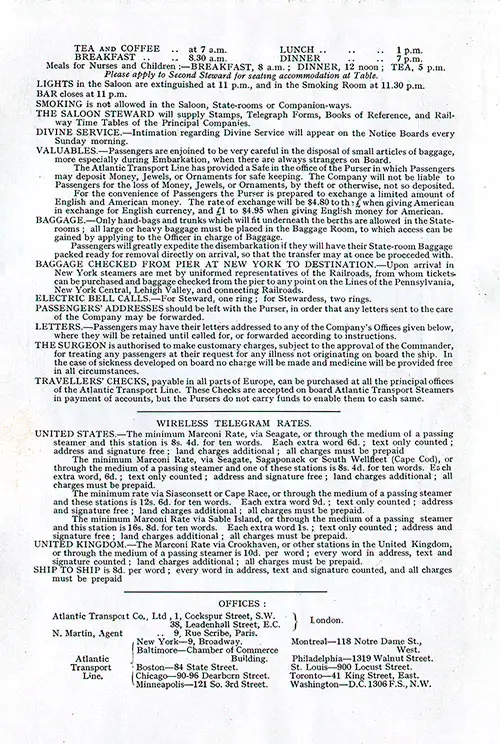
Information for Passengers and Atlantic Transport Co. Offices. SS Minnehaha First Class Passenger List, 5 February 1910. | GGA Image ID # 22c71fae5b

Back Cover: Atlantic Transport Line Track Chart of the North Atlantic Ocean and Memorandum of Log (Unused). A Blank Chart Was Provided for Passengers to Record Their Voyage Across the Atlantic. SS Minnehaha First Class Passenger List, 5 February 1910. | GGA Image ID # 22c72d9ebc
📜 Research note: Some names and captions were typed from originals and may reflect period spellings or minor typographical variations. When searching, try alternate spellings and cross-check with related records. ⚓
Curator’s Note
For over 25 years, I've been dedicated to a unique mission: tracking down, curating, preserving, scanning, and transcribing historical materials. These materials, carefully researched, organized, and enriched with context, live on here at the GG Archives. Each passenger list isn't just posted — it's a testament to our commitment to helping you see the people and stories behind the names.
It hasn't always been easy. In the early years, I wasn't sure the site would survive, and I often paid the hosting bills out of my own pocket. But I never built this site for the money — I built it because I love history and believe it's worth preserving. It's a labor of love that I've dedicated myself to, and I'm committed to keeping it going.
If you've found something here that helped your research, sparked a family story, or just made you smile, I'd love to hear about it. Your experiences and stories are the real reward for me. And if you'd like to help keep this labor of love going, there's a "Contribute to the Website" link tucked away on our About page.
📜 History is worth keeping. Thanks for visiting and keeping it alive with me.
